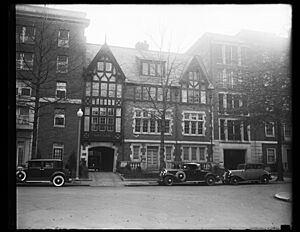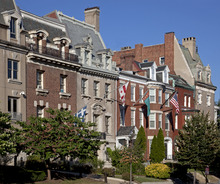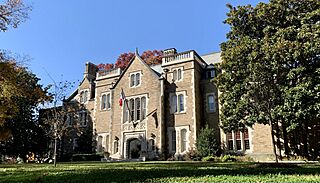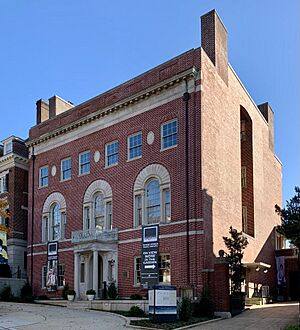Sheridan-Kalorama Historic District facts for kids
|
Sheridan-Kalorama Historic District
|
|
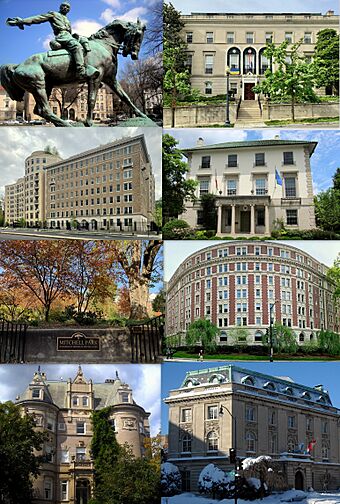
(left to right) Equestrian statue of Philip Sheridan, Dutch ambassadorial residence, Embassy of China's staff residence, Austrian ambassadorial residence, Mitchell Park, The Dresden, Miller House, Embassy of Luxembourg
|
|
| Location | Roughly bounded by Rock Creek Park, Connecticut Avenue, Florida Avenue, 22nd Street, and P Street Washington, D.C., U.S. |
|---|---|
| Area | 190 acres (77 ha) |
| NRHP reference No. | 89001743 |
Quick facts for kids Significant dates |
|
| Added to NRHP | October 30, 1989 |
The Sheridan-Kalorama Historic District is a special neighborhood in the northwest part of Washington, D.C.. It's called a "historic district" because it has many old and important buildings. The area is bordered by Rock Creek Park to the north and west, and by P Street, 22nd Street, and Florida Avenue to the east.
One famous part of the neighborhood is Embassy Row on Massachusetts Avenue. This is where many countries have their embassies. Another nearby historic area is the Kalorama Triangle Historic District. These two neighborhoods are separated by Connecticut Avenue. People often just call both areas "Kalorama" or "Kalorama Heights".
Sheridan-Kalorama has two roundabouts: Kalorama Circle and Sheridan Circle. Sheridan Circle has a statue of General Philip Sheridan on a horse. The name "Kalorama" comes from the Greek words meaning "fine view." The neighborhood also has several parks, like Mitchell Park and the Ukrainian Independence Park. Many buildings here are listed on the National Register of Historic Places (NRHP), meaning they are important historical sites.
Contents
Exploring Sheridan-Kalorama's Location and Parks

The Sheridan-Kalorama Historic District covers about 190 acres (77 ha) in the northwest part of Washington, D.C.. Its borders are Rock Creek Park to the north and west, P Street to the south, and 22nd Street and Florida Avenue to the east. Other historic neighborhoods nearby include Dupont Circle to the south and east, and Kalorama Triangle to the northeast.
Massachusetts Avenue cuts through the neighborhood from south to northwest. Some of the streets here don't follow the usual grid pattern of D.C. because this area was developed later.
Important roads in Sheridan-Kalorama include 23rd Street, 24th Street, California Street, Kalorama Road, S Street, and Wyoming Avenue. You'll find Kalorama Circle on the northern side and Sheridan Circle on the southern side. There are also several parks, with Mitchell Park being the largest. Other parks include Robert Emmet Memorial Park, Sheridan Circle park, and the Ukrainian Independence Park.
The land in the southern part of the neighborhood is mostly flat. As you go north, the land rises, with the highest point near Mitchell Park. The land then drops sharply near Rock Creek Park, especially behind properties on Massachusetts Avenue and Kalorama Road.
A Look Back at Sheridan-Kalorama's Past
Early Days: Native Americans and Estates
The land where Sheridan-Kalorama is today was first home to Native American tribes, the Nacotchtank and Mattawoman. In the 1600s, European settlers arrived. One settler, John Langworth, received a large piece of land in 1663. This land was later called Widow's Mite.
Later, in the late 1700s, the Anthony Holmead family owned a large part of this land. At that time, the area was outside the main city of Washington, D.C., and was part of Maryland. Anthony Holmead II built two houses, one called Rock Hill. In 1791, when Washington, D.C., was planned, Sheridan-Kalorama became part of Washington County, D.C..
The 1800s: From Farmland to Fancy Homes
The Kalorama Estate
In the early 1800s, a politician named William Augustine Washington owned the land. He sold it to the poet Joel Barlow. Barlow renamed his estate "Kalorama," which means "fine view" in Greek. He made many improvements to the estate. Famous people like President Thomas Jefferson and inventor Robert Fulton visited Barlow's home.
After Barlow's death, the property changed hands a few times. During the Civil War, the Kalorama house was used as a smallpox hospital. Sadly, a fire destroyed the house in 1865. Today, Mitchell Park is located where the Kalorama house once stood. After the war, many people moved to Washington, D.C., and more homes were needed.
Building a Neighborhood
After 1871, Washington County became part of the District of Columbia. Transportation improved, and streetcars were added, making it easier for people to live further out. This led to more development in areas like Dupont Circle and then Kalorama Triangle.
Sheridan-Kalorama was still mostly rural for a while. However, land values increased as development moved north. The neighborhood was divided into smaller lots for building. Wealthy residents preferred Sheridan-Kalorama, while Kalorama Triangle became home to more middle-class families. Large, fancy houses were built along Massachusetts Avenue.
By the late 1890s, more homes were built throughout the neighborhood. These included stand-alone houses and typical rowhouses. One of these early houses is now the Embassy of North Macedonia.
The 1900s: Embassies Arrive
Growth and Change
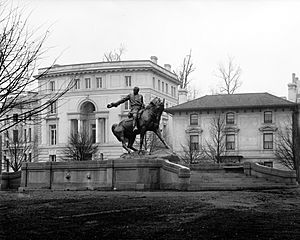
In the early 1900s, Sheridan-Kalorama really started to change. Large estates were bought, divided, and new suburban-style homes were built. By 1900, about 20% of the houses that are still there today had been built. A stone bridge was built over Rock Creek on Massachusetts Avenue, which was later replaced.
Unlike Kalorama Triangle, which had more rowhouses and apartment buildings for the middle-class, Sheridan-Kalorama attracted the upper-class. Land here was very expensive. Grand homes were built along Massachusetts Avenue, setting the style for the rest of the neighborhood. Many houses were designed in the Colonial Revival style, but other styles like Federal and Beaux-Arts were also popular.
The neighborhood's name changed when Decatur Circle was renamed Sheridan Circle, honoring the Civil War hero. Sheridan-Kalorama became a distinct, upscale neighborhood. Early residents included diplomats, members of Congress, lawyers, and military officers.
Some older houses were torn down to make way for even grander residences. Many rowhouses near Connecticut Avenue were replaced with large apartment buildings. By World War I, most residents lived in apartment buildings due to their size. Famous examples include The Highlands and The Dresden.
The neighborhood also had schools like Maret School and places of worship such as St. Margaret's Episcopal Church and the Islamic Center of Washington.
The Rise of Embassy Row
As the 20th century continued, many of the neighborhood's large houses were sold to foreign governments. France was one of the first countries to buy land for an embassy here. The first embassy building built specifically for that purpose was the Embassy of Siam (now Thailand).
By 1929, most of the current buildings in the neighborhood had been constructed. During the Great Depression, many mansions were sold to foreign governments. This trend continued for decades, making Sheridan-Kalorama home to many embassies and ambassadorial residences. The neighborhood's quiet, suburban feel and prestige attracted these nations.
By 1993, over 25% of the neighborhood's buildings were owned by foreign countries. In 1989, Sheridan-Kalorama was officially listed as a historic district to help protect its unique character.
The 2000s: A Home for Presidents and Leaders
In the early 2000s, some embassy buildings continued to be developed. For example, China replaced an old apartment building with a new one for its embassy staff. Sheridan-Kalorama has always been a place where wealthy people and important officials live.
Several U.S. presidents have lived in Sheridan-Kalorama, including William Howard Taft, Woodrow Wilson, Warren G. Harding, Herbert Hoover, Franklin D. Roosevelt, and most recently, Barack Obama. After his presidency, Barack Obama and his family moved into a large house here in 2017. Other famous residents include Supreme Court justices, members of Congress, and military leaders.
Another notable resident is Jeff Bezos, the founder of Amazon. He bought a large property in 2017, which is now the biggest house in Washington, D.C.
Important Historic Landmarks and Embassies
Historic Landmarks in Sheridan-Kalorama
Many of the historic buildings in Sheridan-Kalorama are also part of the Massachusetts Avenue Historic District. The Sheridan-Kalorama Historic District itself was added to the District of Columbia Inventory of Historic Sites (DCIHS) and the National Register of Historic Places (NRHP) in 1989.
Some of the important landmarks listed on the NRHP and DCIHS include:
- The Alice Pike Barney Studio House
- The Meeting House of the Friends Meeting of Washington
- The Embassy of Japan
- The Lindens (a house moved from Massachusetts and rebuilt here)
- The equestrian statue of Philip Sheridan
- The Tucker House and Myers House (once home to the Textile Museum)
There are also four National Historic Landmarks in the neighborhood:
- The Charles Evans Hughes House
- The Woodrow Wilson House
- The William E. Borah Apartment
- The Frances Perkins House
Many other significant buildings contribute to the historic feel of the neighborhood. These include:
- The Church of the Pilgrims
- The Dresden
- The Embassy of Thailand's Consular Section
- The Edward Hamlin Everett House
- The French ambassadorial residence
- The Highlands
- The Islamic Center of Washington
- The Miller House
- Saint Margaret's Episcopal Church
- The Spanish Steps
Embassies in the Neighborhood
Sheridan-Kalorama is famous for its many diplomatic buildings. Dozens of countries have their embassies or ambassadorial residences here. Some of these include:
- The Embassy of Algeria
- The Embassy of Armenia
- The Embassy of Bulgaria
- The Embassy of China (staff residence)
- The Embassy of Croatia
- The Embassy of Greece
- The Embassy of Ireland
- The Embassy of Japan
- The Embassy of South Korea
- The Embassy of Luxembourg
- The Embassy of North Macedonia
- The Embassy of Romania
- The Embassy of Slovenia
- The Embassy of Turkey
Some embassies have closed, like the Embassy of Afghanistan in 2022 and the Embassy of Syria in 2014.
Images for kids



